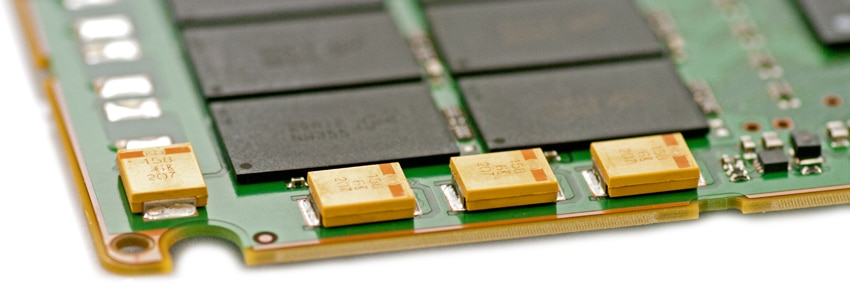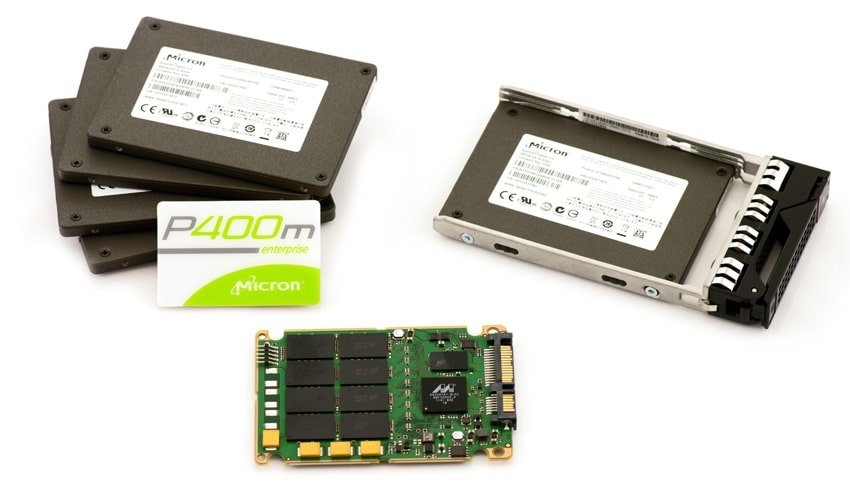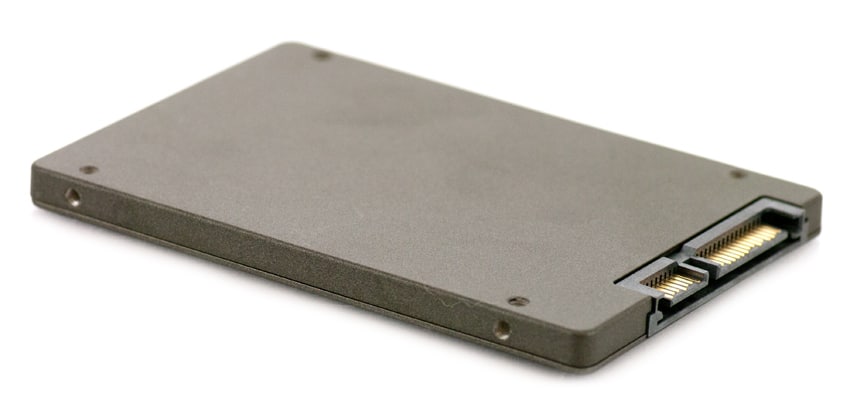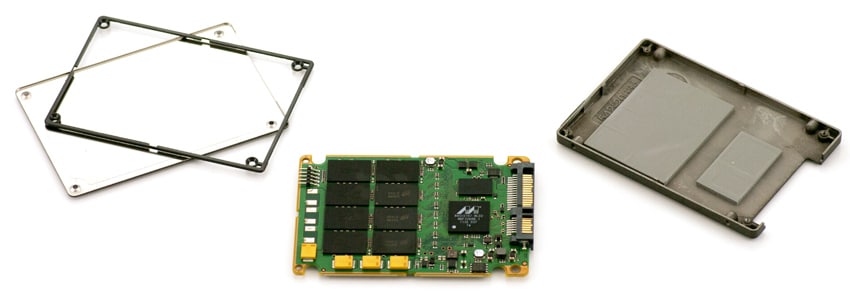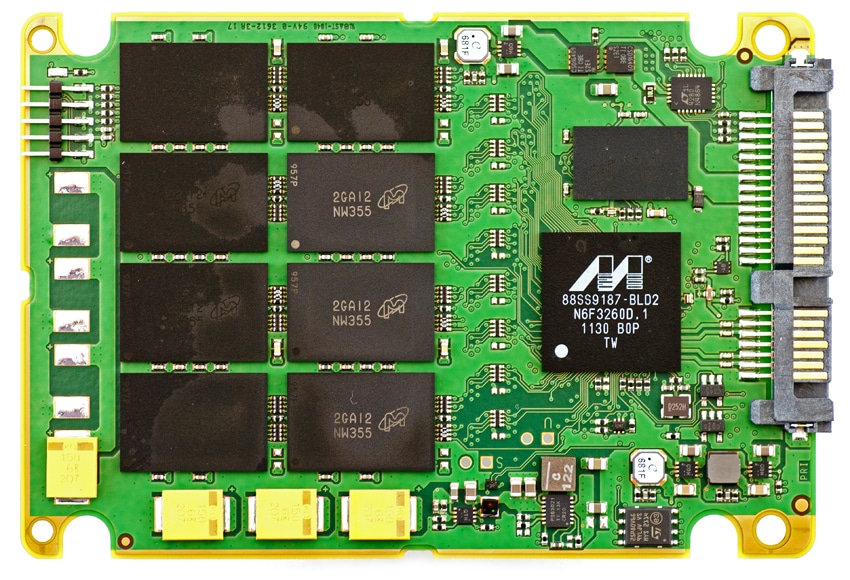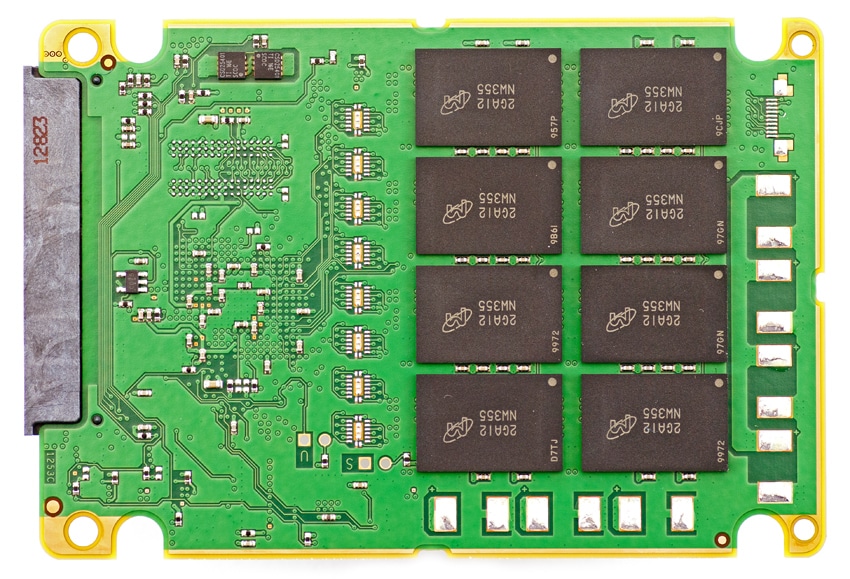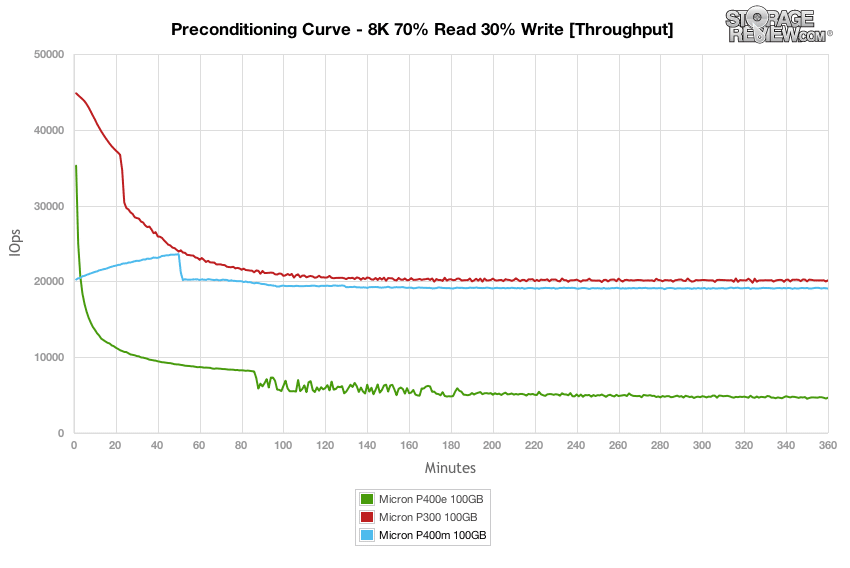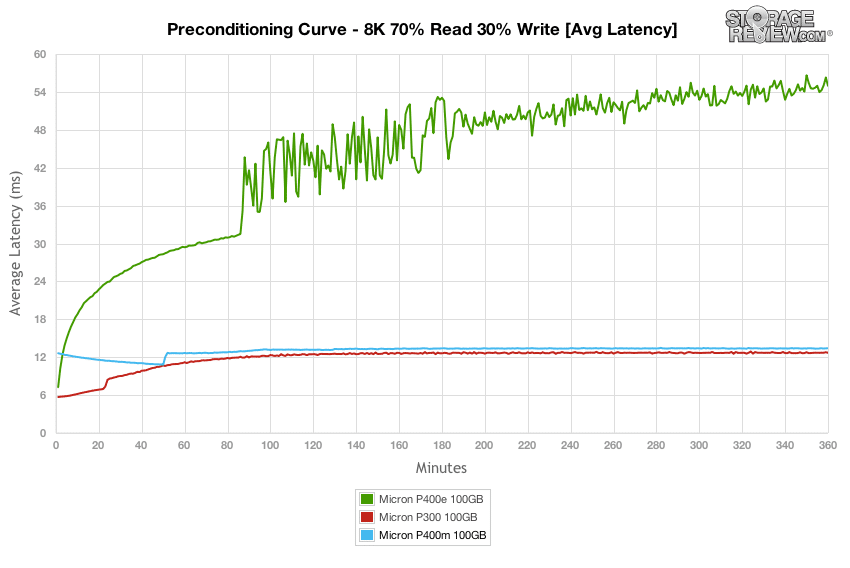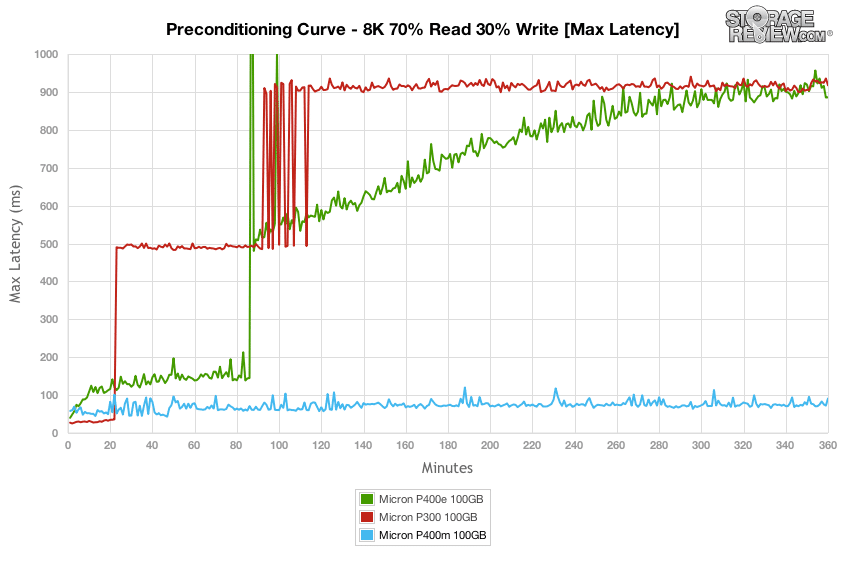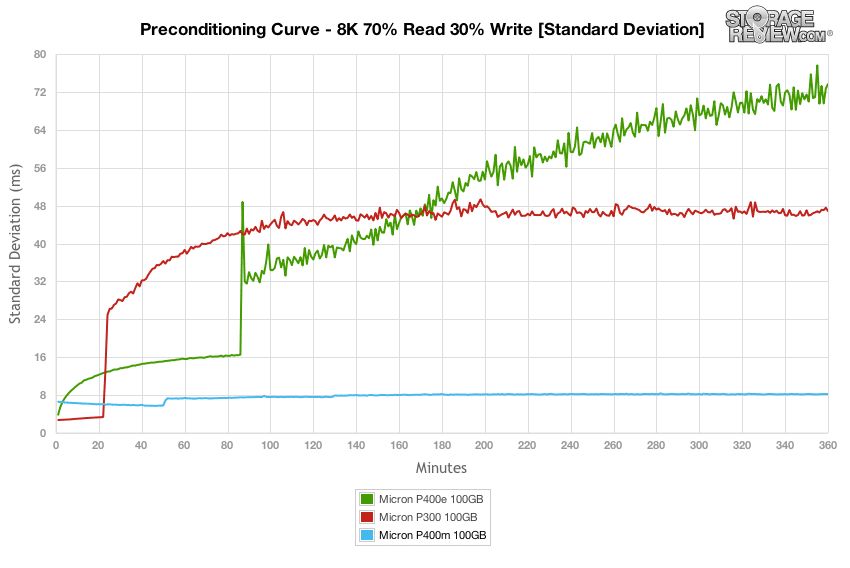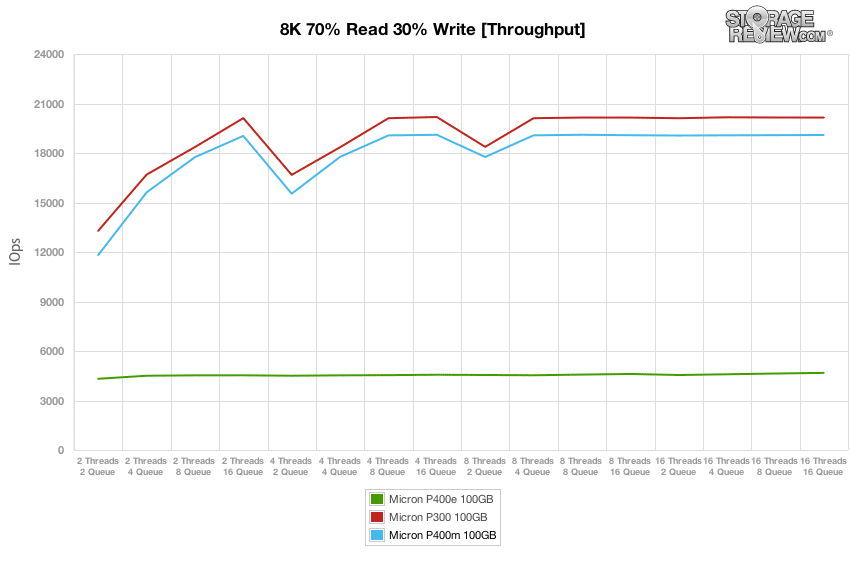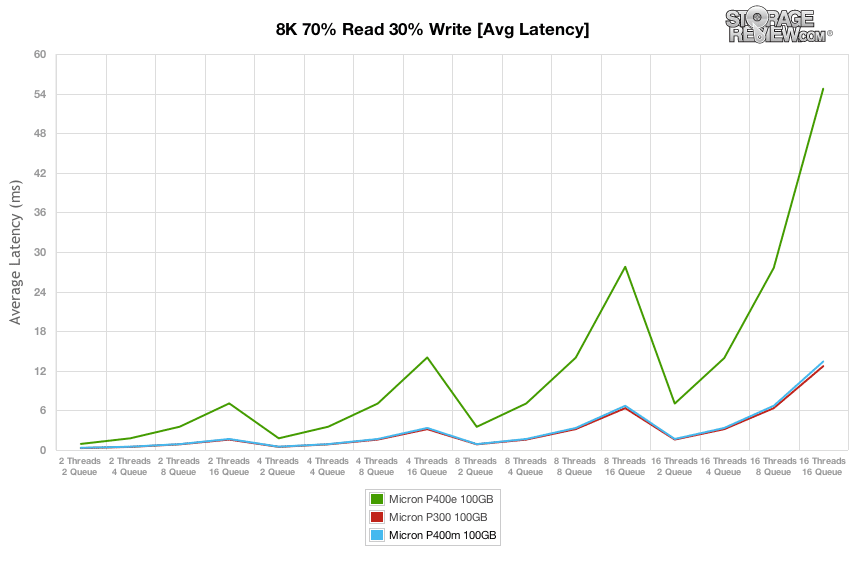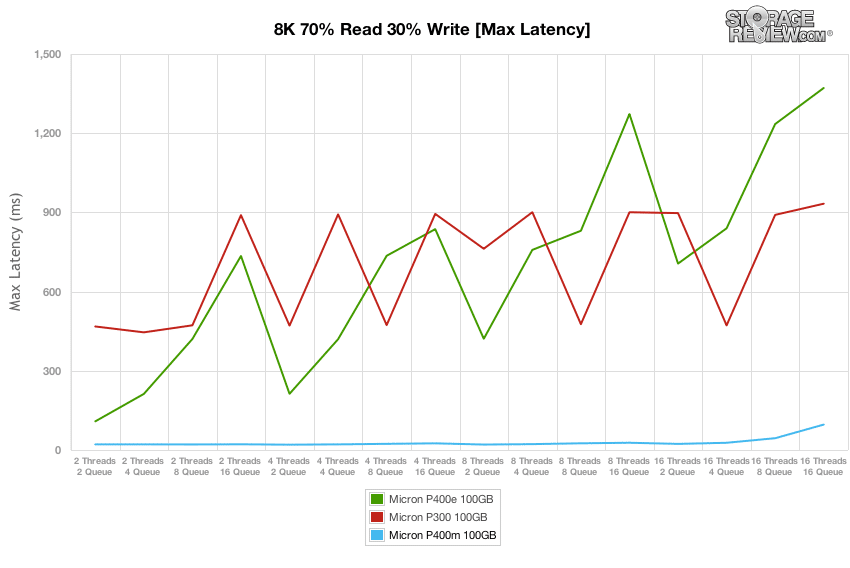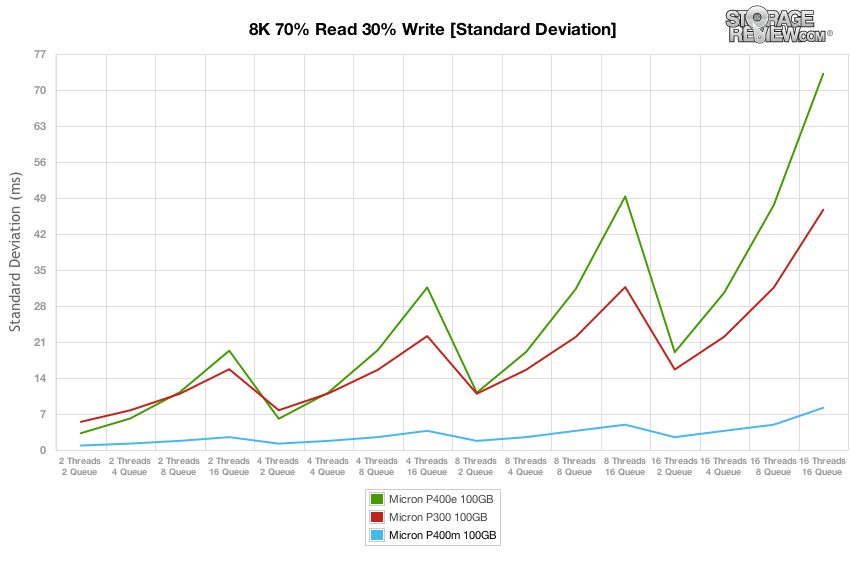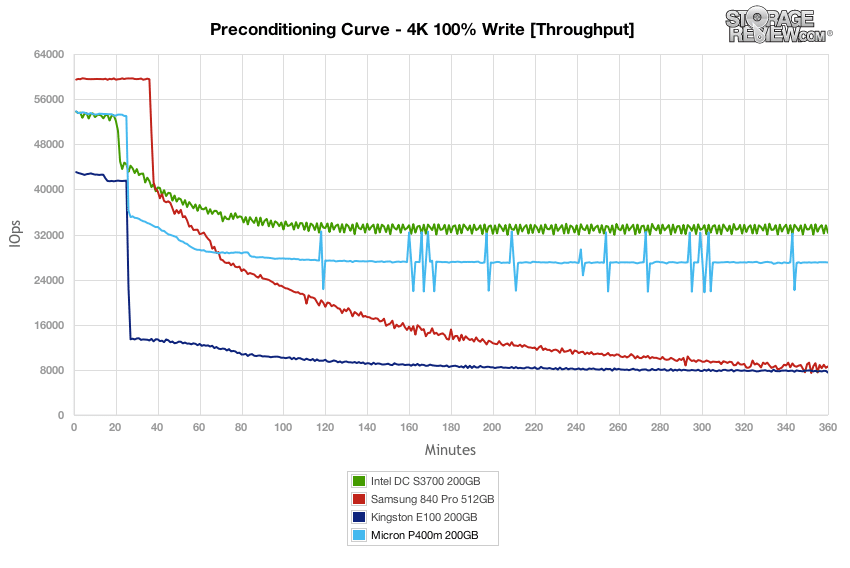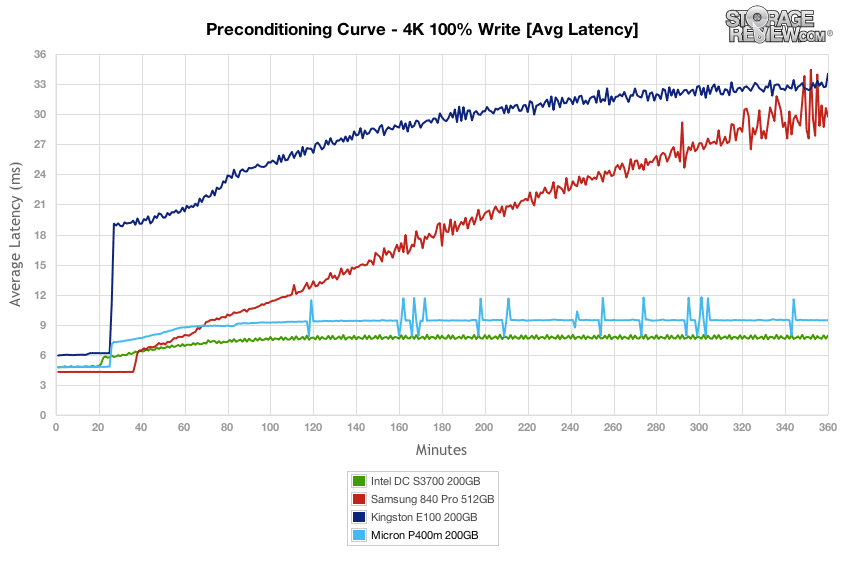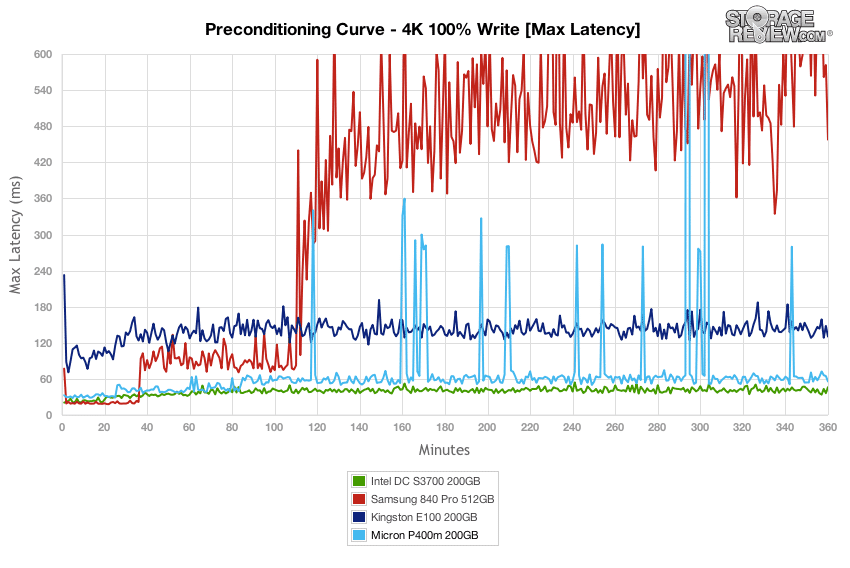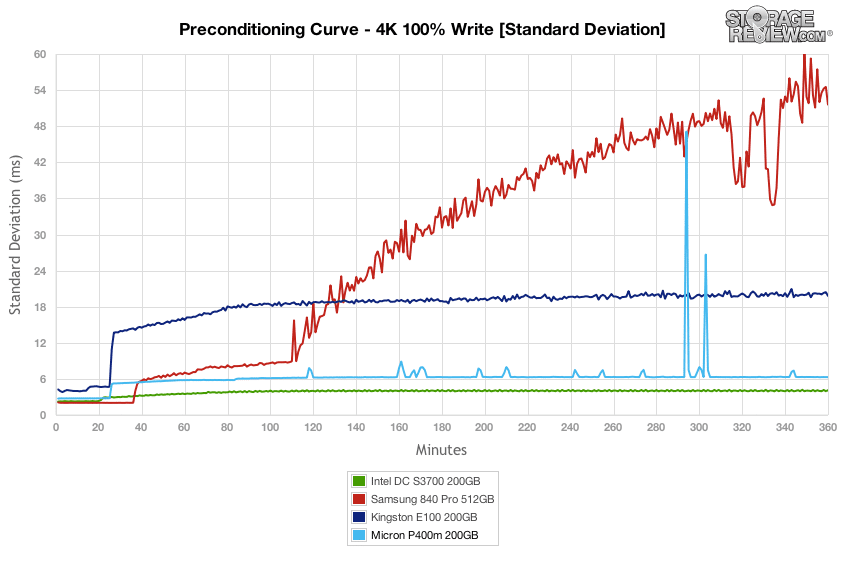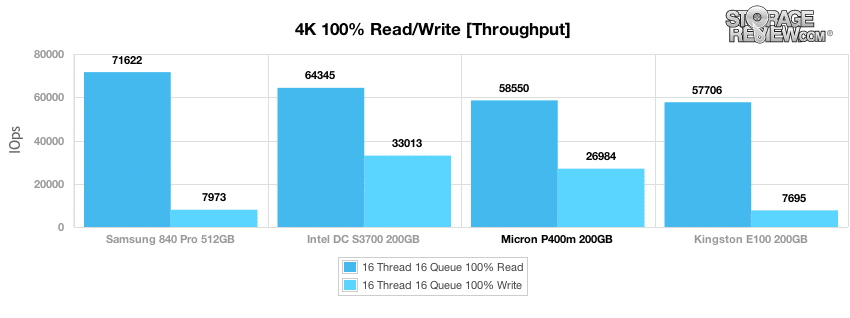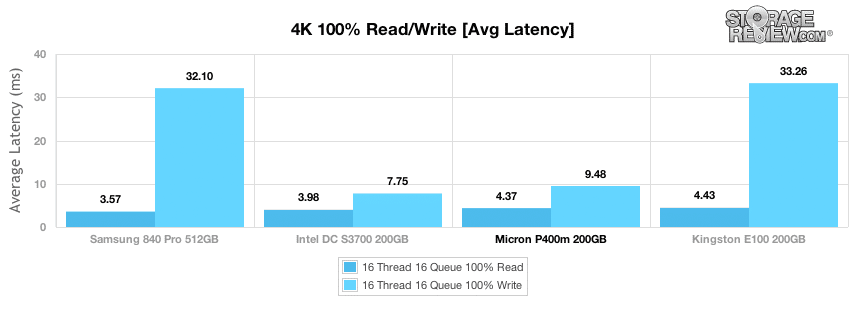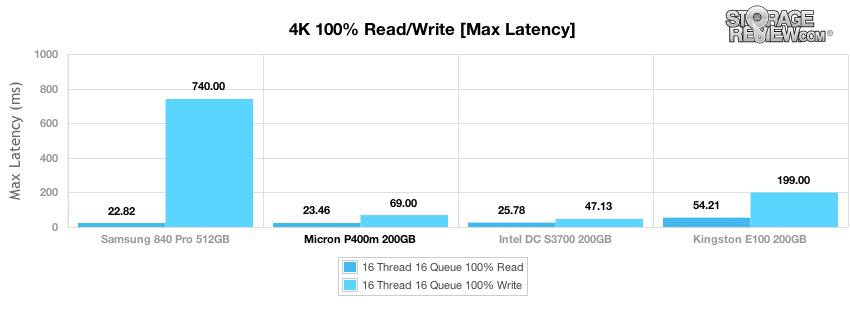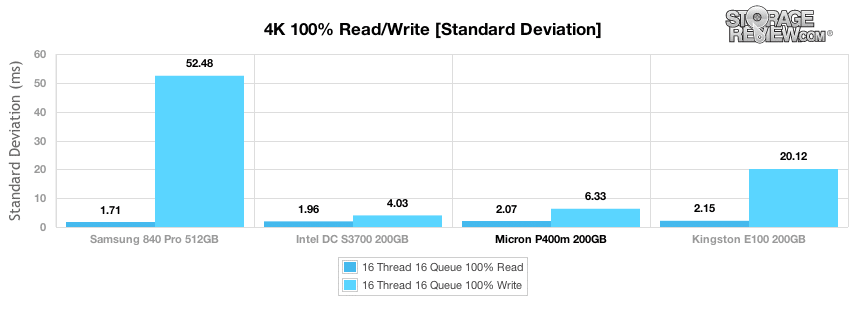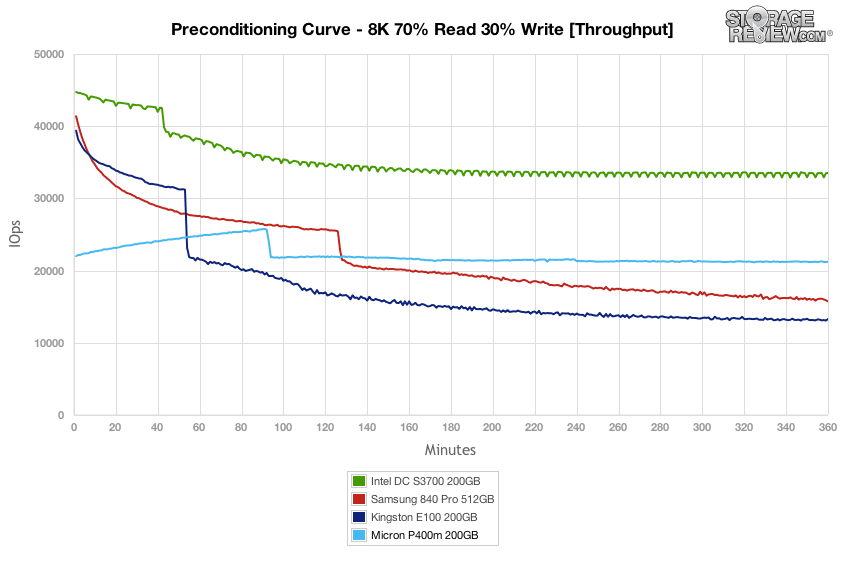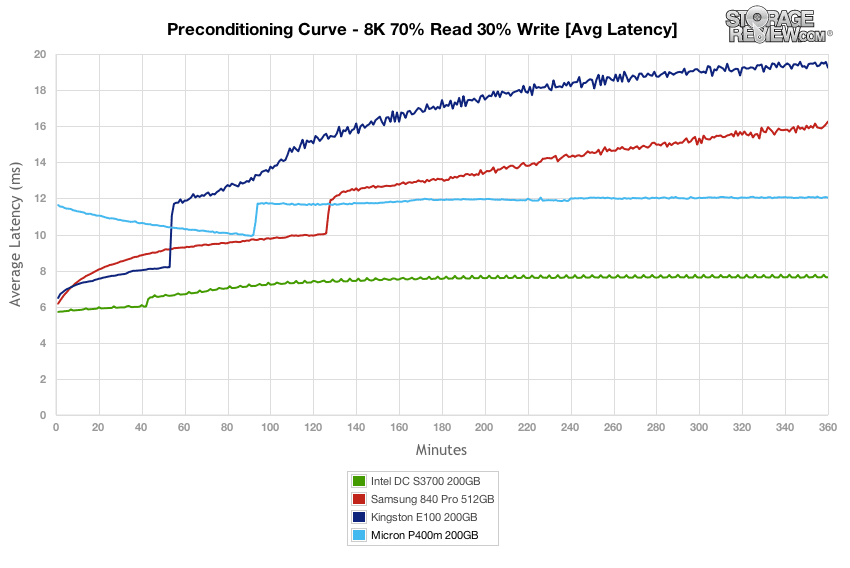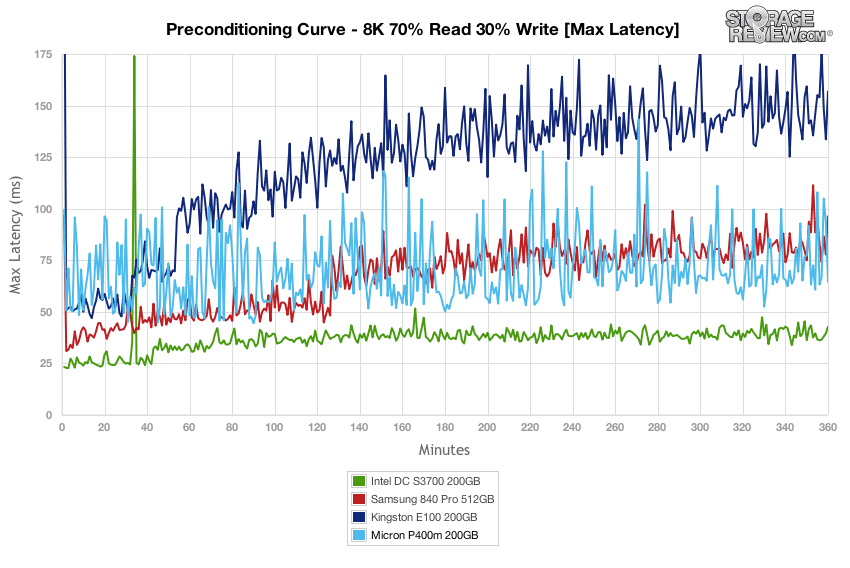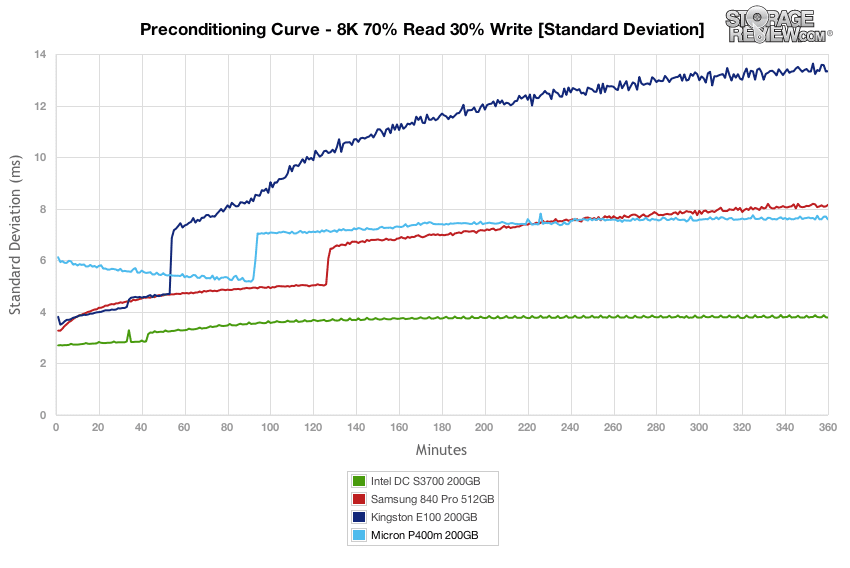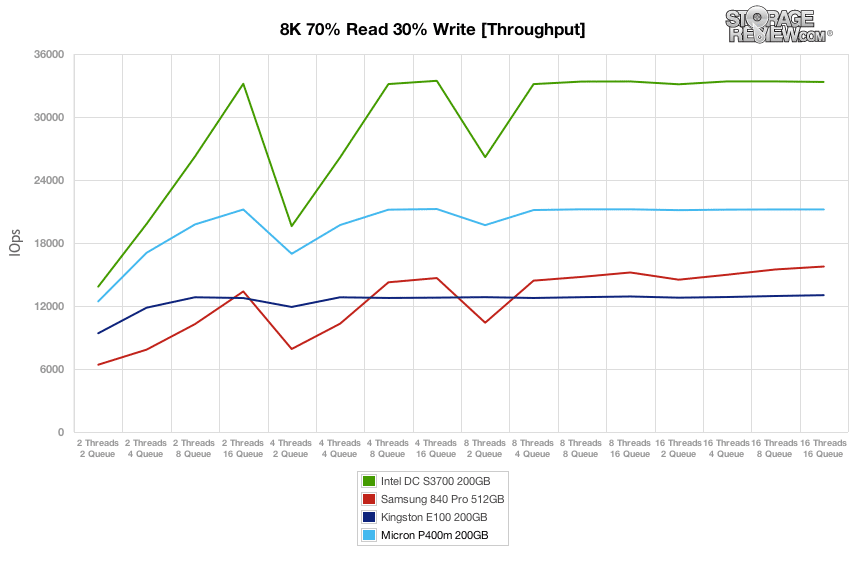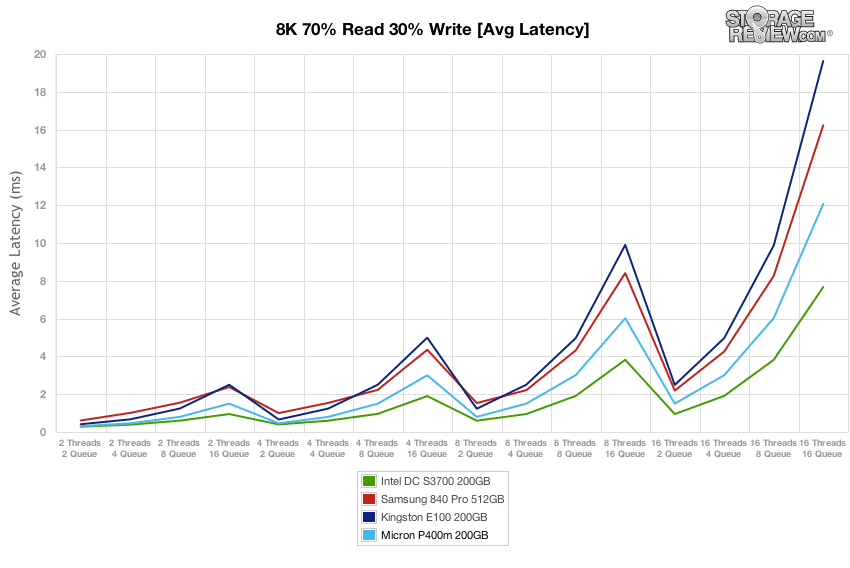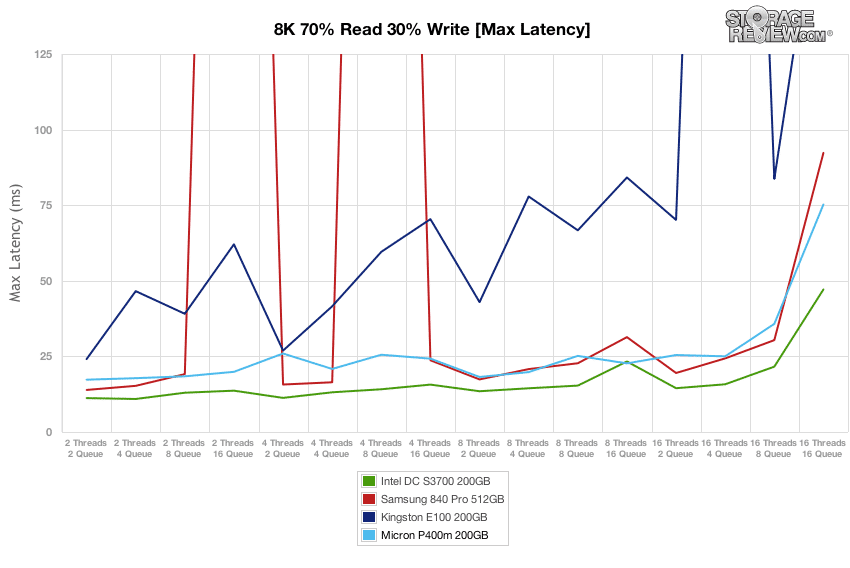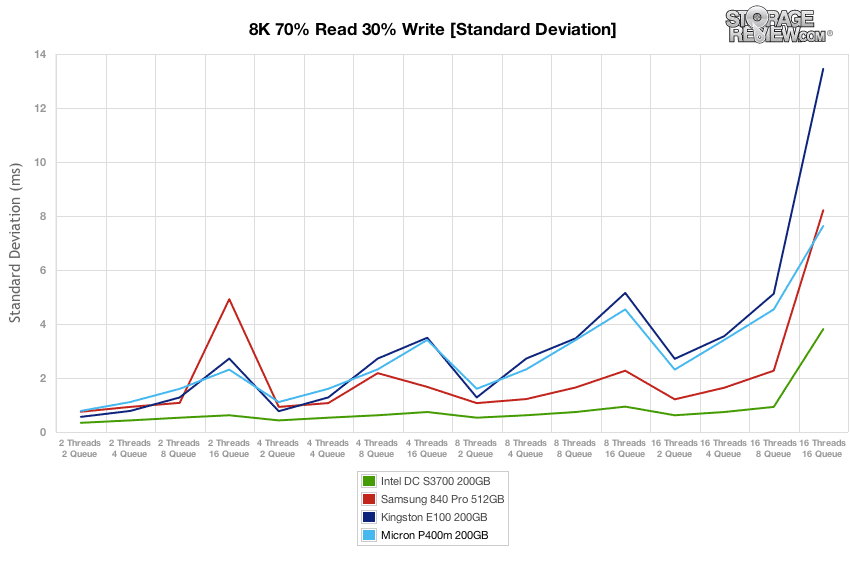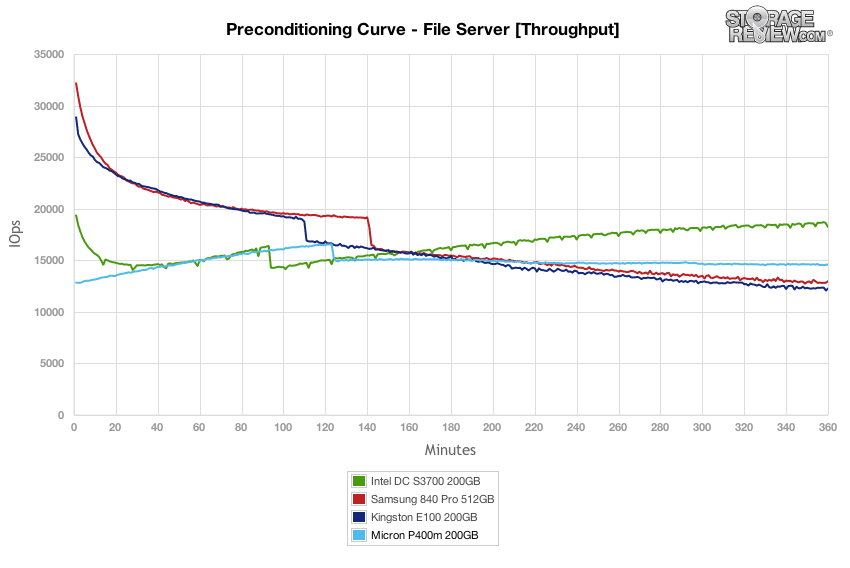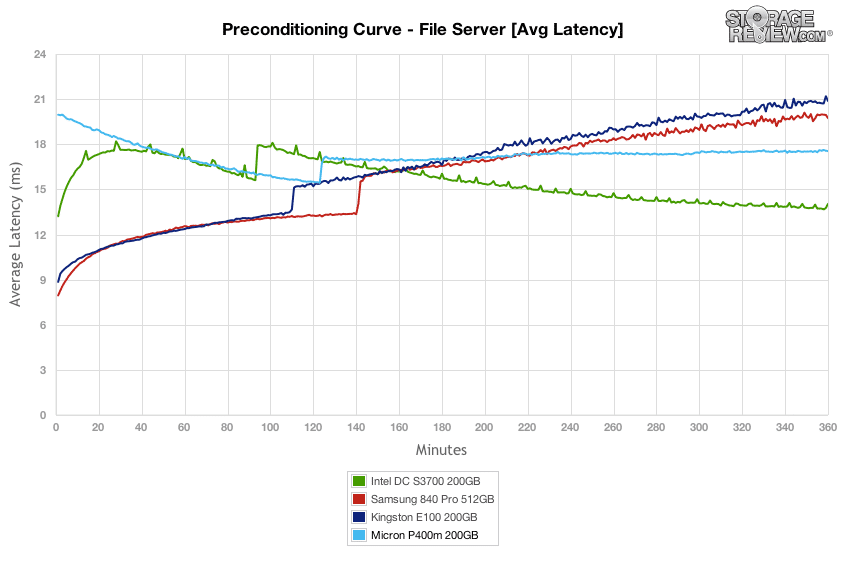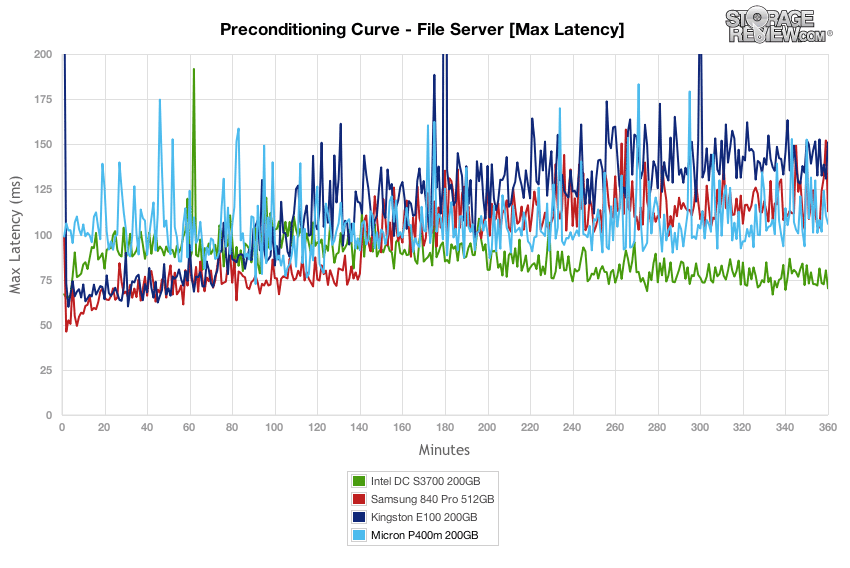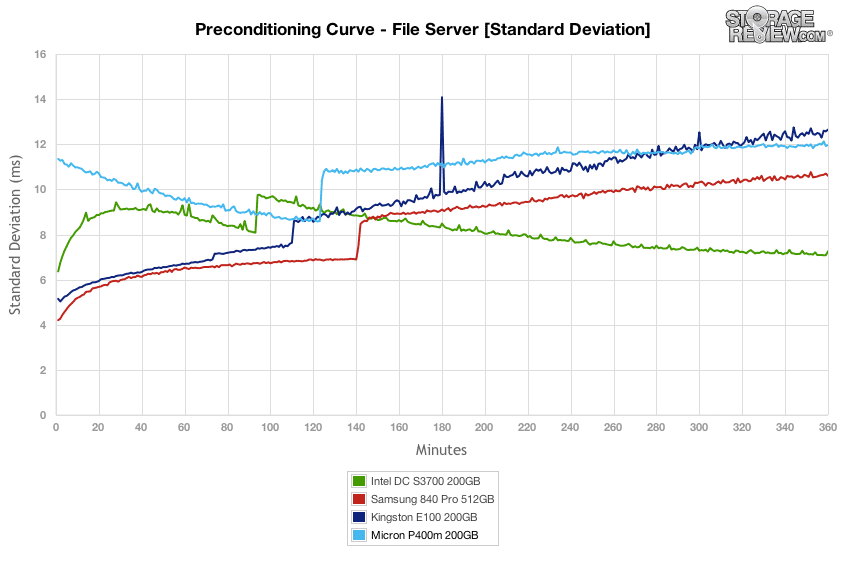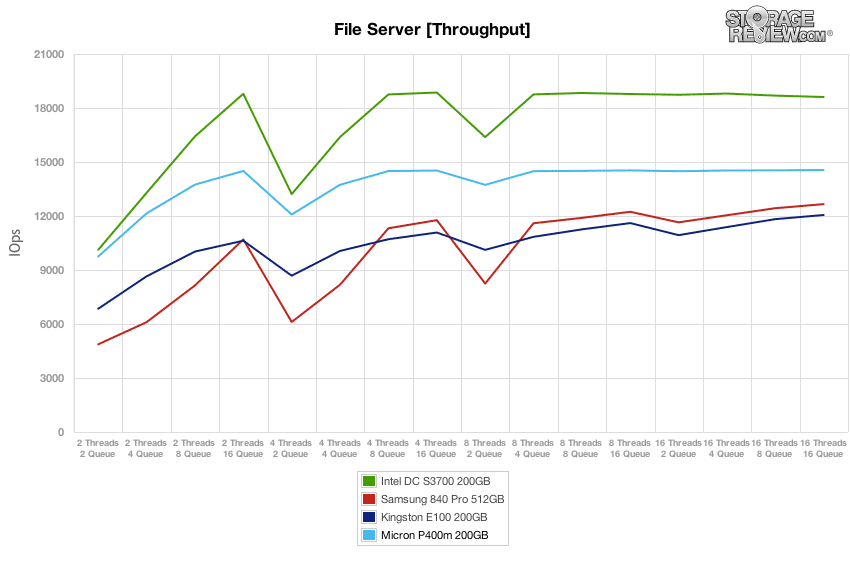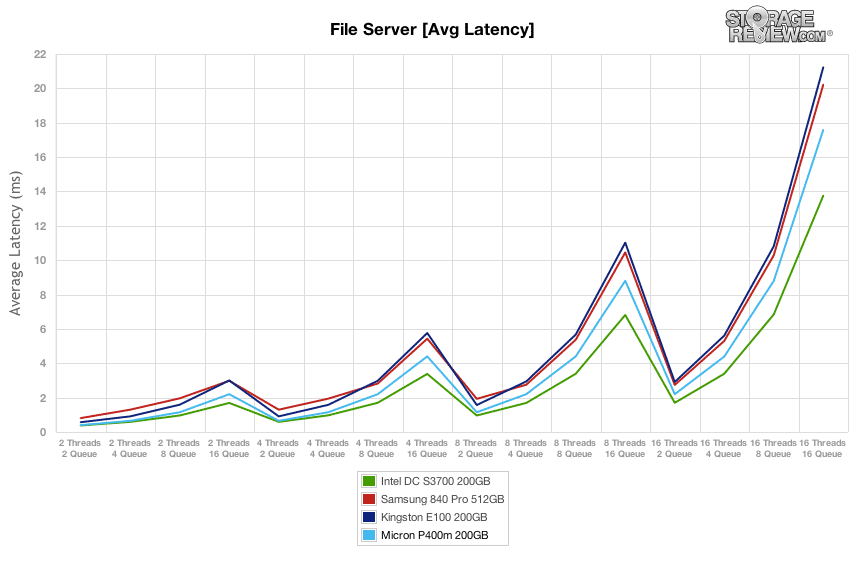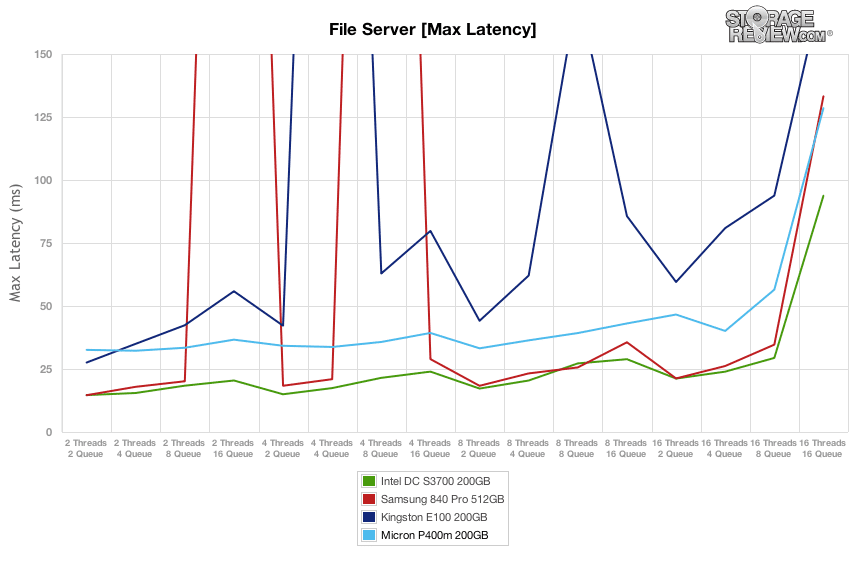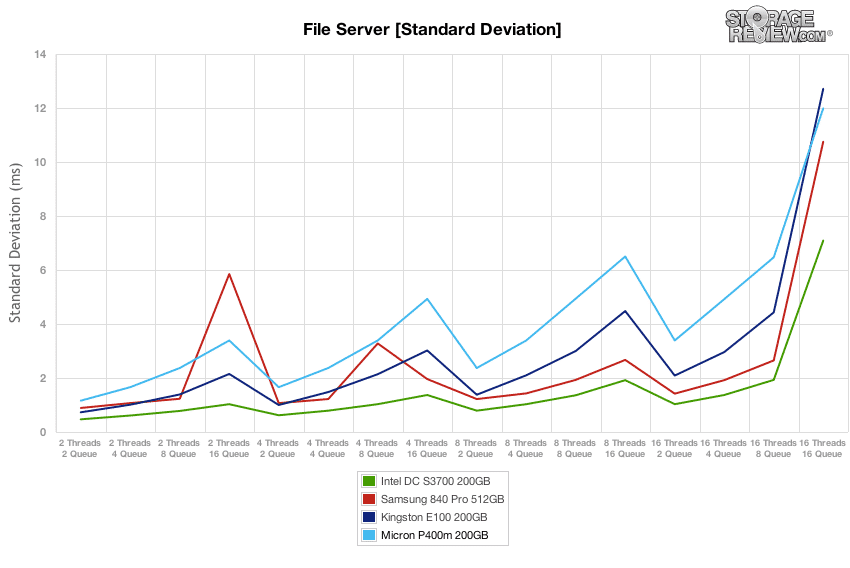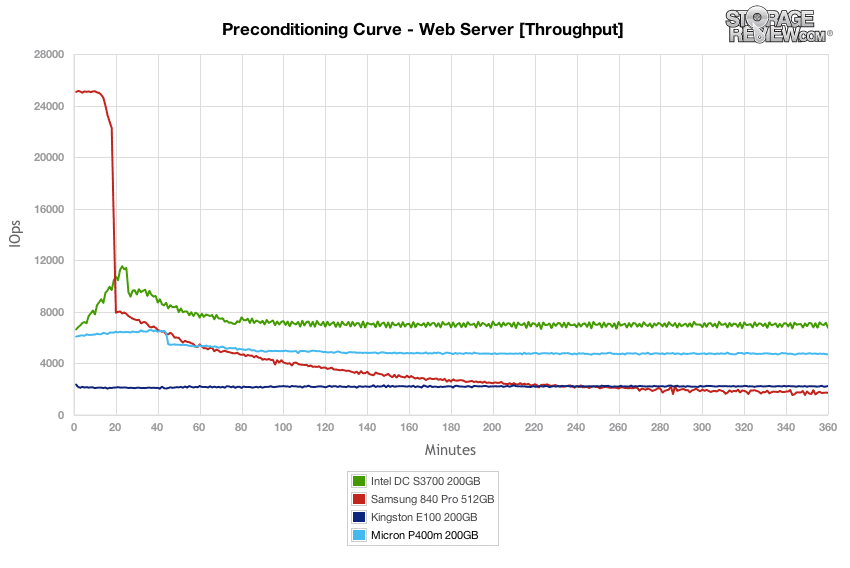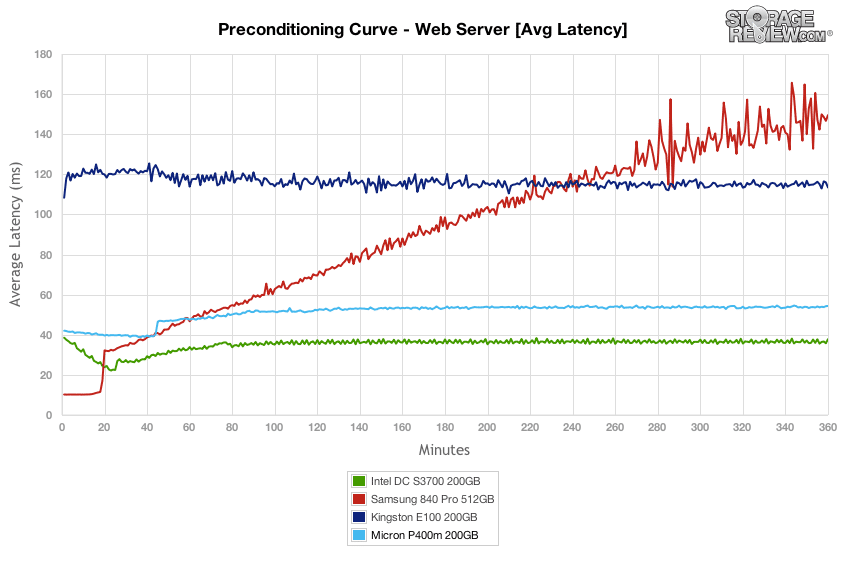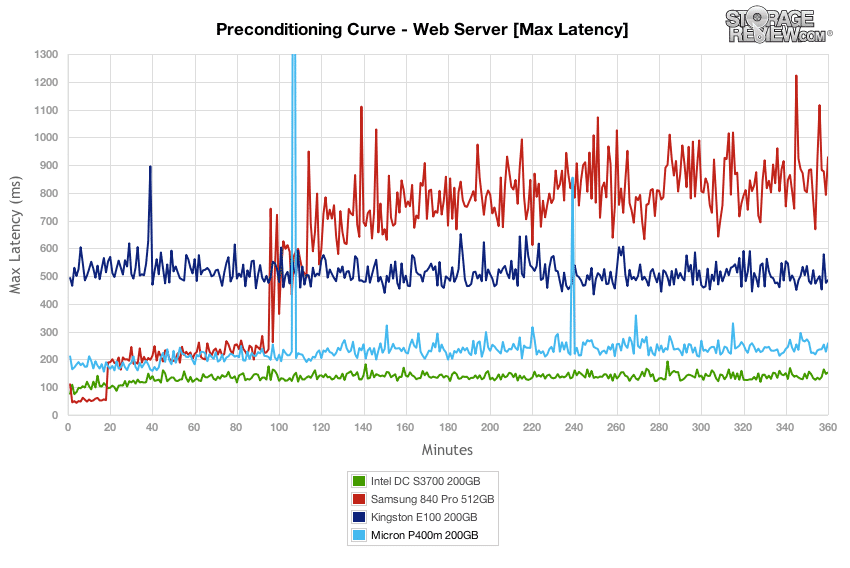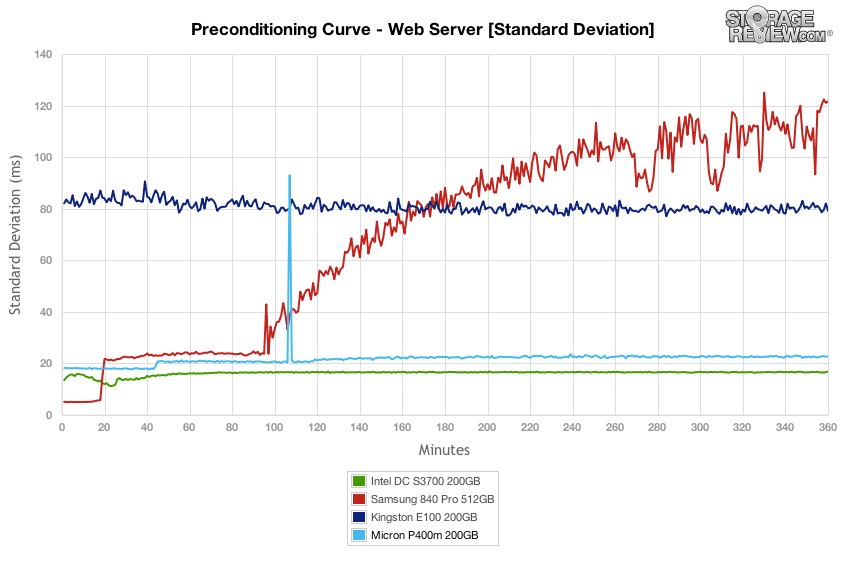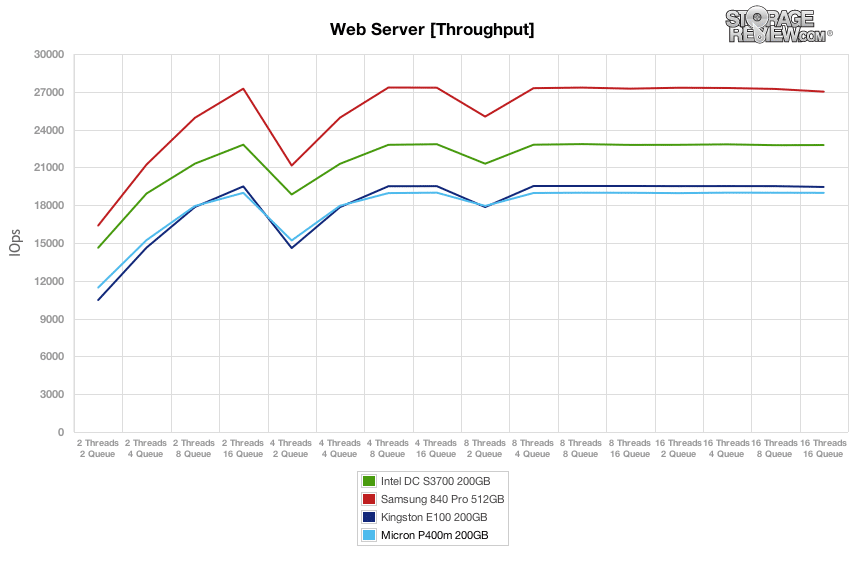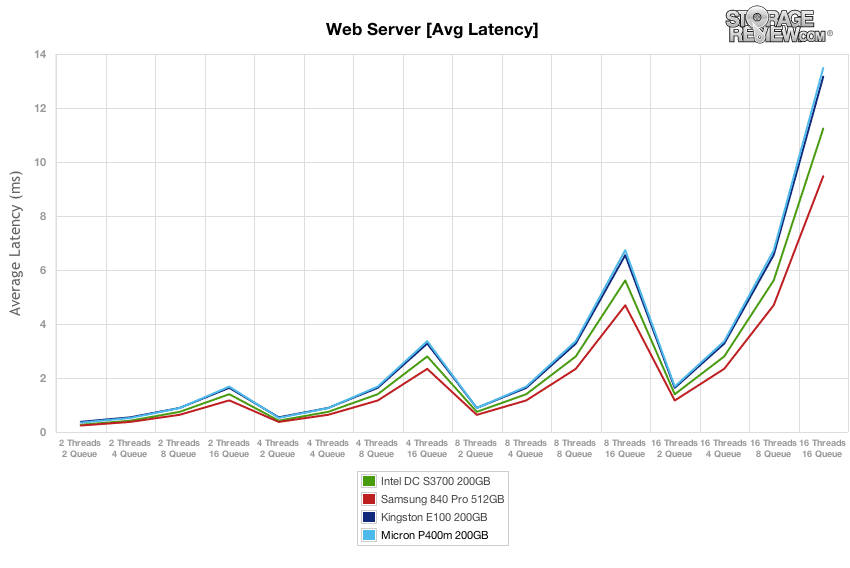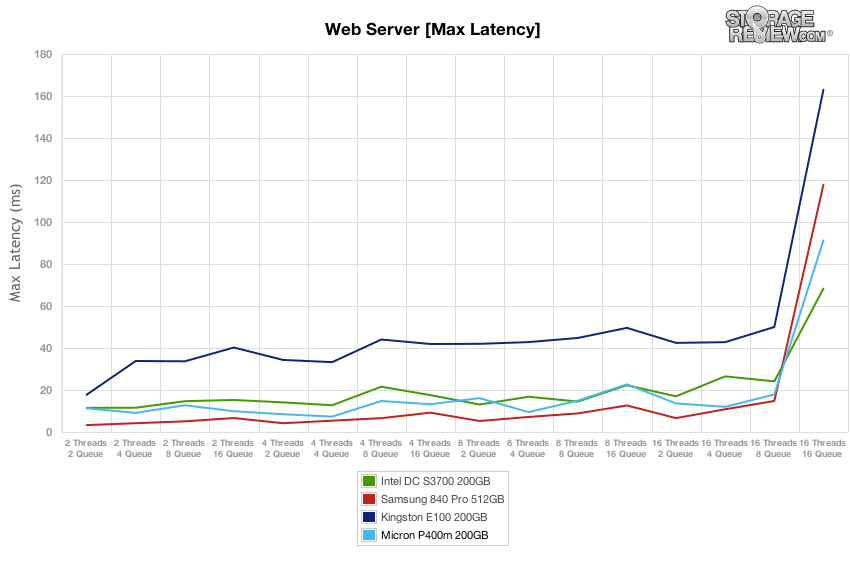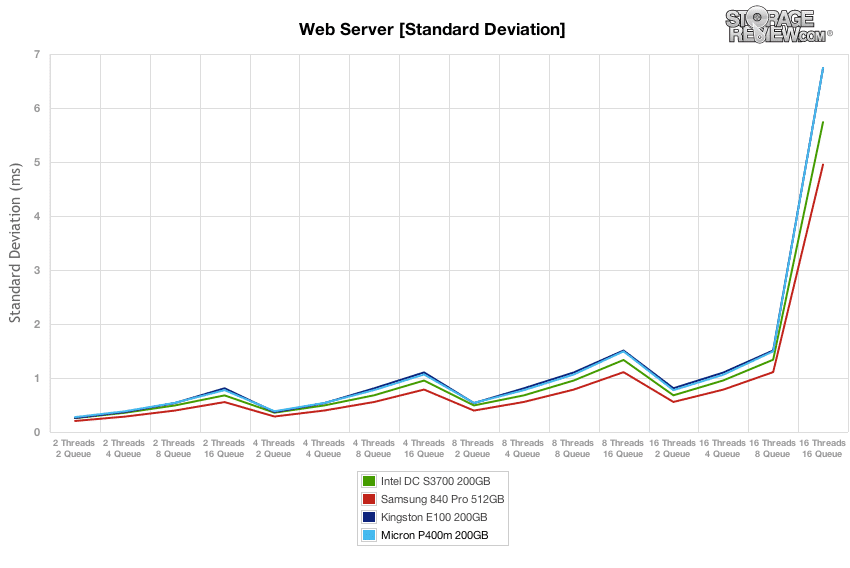
The Micron P400m is an enterprise SSD engineered for use in servers, appliances and storage platforms. The P400m uses a mainstream 7mm 2.5″ form factor, SATA interface and Micron’s 25nm MLC NAND. Like the P300 this drive replaces, the P400m uses a Marvell drive controller with customized Micron firmware on top that has been tuned for performance under even read and write usage scenarios. From a performance perspective, the P400m delivers 64KB sequential reads and writes of 380MB/s and 310MB/s respectively, with 4KB random read and write IOPS of up to 60,000 and 26,000.
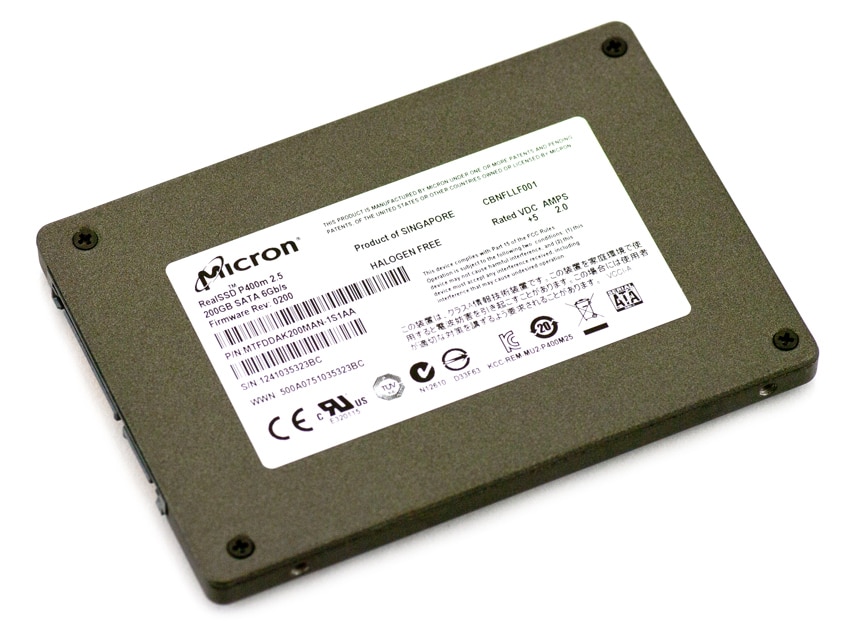
Beyond peak performance, the P400m includes Micron’s XPERT (extended performance and enhanced reliability technologies) portfolio to deliver on the features enterprise customers care about most: endurance, data protection, consistent performance, low latency and low power consumption. These features are largely personified by the P400m’s firmware and drive architecture, which is developed by Micron in-house with Micron NAND. The advantages of having an internal development team who can coordinate with NAND architects are evident in terms of drive features, but also in harder to define ways like compatibility and drive reliability. Micron also includes capacitors with the P400m, which protects data in-flight during an unexpected loss of power.
The P400m is the latest refresh in Micron’s growing enterprise SSD portfolio. This drive slots in as a mainstream server, storage and cache option where the read and write activity is balanced. This contrasts with the P400e, which is a read-centric entry enterprise drive and the P320h PCIe application accelerator which is Micron’s premium enterprise storage offering. In aggregate the lines accommodate most needs but Micron plans to continue to expand their offerings to include additional interface and NAND configuration options to meet the specific flash needs of more use cases.
The P400m ships in 100GB, 200GB and 400GB capacities with endurance figures of 10 drive write fills per day for five years. Our primary review units are the 200GB capacity, with 100GB and 400GB samples on hand for specific tests.
Micron P400m Specifications
- Capacities
- 100GB (MTFDDAK100MAN-1S1AA)
- Sequential 64KB read: 380 MB/s
- Sequential 64KB write: 200 MB/s
- Random 4KB read: 52,000 IOPS
- Random 4KB write: 21,000 IOPS
- READ latency: 0.57ms
- WRITE latency: 2ms
- 200GB (MTFDDAK200MAN-1S1AA)
- Sequential 64KB read: 380 MB/s
- Sequential 64KB write: 310 MB/s
- Random 4KB read: 54,000 IOPS
- Random 4KB write: 26,000 IOPS
- READ latency: 0.51ms
- WRITE latency: 2ms
- 400GB (MTFDDAK400MAN-1S1AA)
- Sequential 64KB read: 380 MB/s
- Sequential 64KB write: 310 MB/s
- Random 4KB read: 60,000 IOPS
- Random 4KB write: 26,000 IOPS
- READ latency: 0.51ms
- WRITE latency: 2ms
- 100GB (MTFDDAK100MAN-1S1AA)
- Micron 25nm MLC NAND Flash
- Marvell 9187 SATA 6.0Gb/s Controller
- SATA 6 Gb/s interface
- ATA modes supported
- PIO mode 3, 4
- Multiword DMA mode 0, 1, 2
- Ultra DMA mode 0, 1, 2, 3, 4, 5
- Enterprise sector size support: 512-byte
- Hot-plug capable
- Native command queuing support with 32-command
slot support - ATA-8 ACS2 command set compliant
- ATA security feature command set and password
login support - Secure erase command set: Fast and secure erase
- Self-monitoring, analysis, and reporting technology
(SMART) command set - Reliability
- Mean time to failure (MTTF): 2 million device hours
- Static and dynamic wear leveling
- Uncorrectable bit error rate (UBER): <1 sector per 1016 bits read
- Endurance: Total bytes written (TBW)
- 100GB: 1.75PB
- 200GB: 3.50PB
- 400GB: 7.00PB
- Mechanical: 7.0mm height
- SATA connector: 5V ±10%
- 2.5-inch drive: 100.5mm x 69.85mm x 7.0mm
- Field-upgradeable firmware
- Power consumption: <7.5W (TYP), <0.75W Idle
- Operating temperature
- Commercial 0°C to 70°C
- Weight <125g MAX
Build and Design
The 200GB Micron P400m has a design mirroring the look of the family of drives from Crucial and Micron. The case is very simple, with metallic gray paint. The body is made of metal alloy, with a sturdy metal top cover. To fit the growing market segment that relies on super-thin SSDs, Micron went with the small 7mm z-height for the P400m to give it the widest range of compatibility. In our lab environment, we had no problem mounting the Micron P400m in solutions that were designed around 15mm SAS HDDs, or new blade servers that only fit 7mm SSDs or HDDs.
The front of the Micron P400m offers the industry-standard SATA power and data connection. All firmware updates are handled through software inside or outside of the OS.
The design of the P400m doesn’t differ much from the client or other enterprise SSDs Micron sells.
Utilizing the Marvell 9187 controller the P400m offers enhanced firmware features for enterprise usage. The most notable is the increased over-provisioning, which brings the drive capacity down from a raw 340GB to an OS-usable 186GB. This helps with background activities during heavy-write workloads, as well as increases the drive lifespan. This is important, as the P400m has over-provisioning and optimizations which help improve the endurance levels of the MLC NAND to match SLC-solutions.
Testing Background and Comparables
The Micron RealSSD P400m uses Micron 25nm MLC NAND and a Marvell 9187 controller with a SATA 6.0Gb/s interface.
Comparables for this review:
- Intel SSD DC S3700 (200GB, Intel PC29AS21CA0 controller, Intel 25nm HET MLC NAND, 6.0Gb/s SATA)
- Kingston SSDNow E100 (200GB, SandForce SF-2500 controller, Toshiba 24nm eMLC NAND, 6.0Gb/s SATA)
- Samsung SSD 840 Pro (512GB, 300mhz Samsung 3-core MCX controller, Samsung 2x nm Toggle NAND Flash, SATA)
All SAS/SATA enterprise SSDs are benchmarked on our second-generation enterprise testing platform based on a Lenovo ThinkServer RD630. This new Linux-based testing platform includes the latest interconnect hardware such as the LSI 9207-8i HBA as well as I/O scheduling optimizations geared towards best-case flash performance. For synthetic benchmarks, we utilize FIO version 2.0.10 for Linux and version 2.0.12.2 for Windows.
- 2 x Intel Xeon E5-2620 (2.0GHz, 15MB Cache, 6-cores)
- Intel C602 Chipset
- Memory – 16GB (2 x 8GB) 1333Mhz DDR3 Registered RDIMMs
- Windows Server 2008 R2 SP1 64-bit, Windows Server 2012 Standard, CentOS 6.3 64-Bit
- 100GB Micron RealSSD P400e Boot SSD
- LSI 9211-4i SAS/SATA 6.0Gb/s HBA (For boot SSDs)
- LSI 9207-8i SAS/SATA 6.0Gb/s HBA (For benchmarking SSDs or HDDs)
- Mellanox ConnectX-3 10GbE PCIe 3.0 Adapter
- Mellanox ConnectX-3 InfiniBand PCIe 3.0 Adapter
Enterprise Synthetic Workload Analysis
Flash performance varies throughout the preconditioning phase of each storage device. Our enterprise storage benchmark process begins with an analysis of the way the drive performs during a thorough preconditioning phase. Each of the comparable drives are secure erased using the vendor’s tools, preconditioned into steady-state with the same workload the device will be tested with under a heavy load of 16 threads with an outstanding queue of 16 per thread, and then tested in set intervals in multiple thread/queue depth profiles to show performance under light and heavy usage.
Preconditioning and Primary Steady-State Tests:
- Throughput (Read+Write IOPS Aggregate)
- Average Latency (Read+Write Latency Averaged Together)
- Max Latency (Peak Read or Write Latency)
- Latency Standard Deviation (Read+Write Standard Deviation Averaged Together)
Our Enterprise Synthetic Workload Analysis includes four profiles based on real-world tasks. These profiles have been developed to make it easier to compare to our past benchmarks as well as widely-published values such as max 4K read and write speed and 8K 70/30, which is commonly used for enterprise drives. We also included two legacy mixed workloads, the traditional File Server and Webserver, each offering a wide mix of transfer sizes.
- 4K
- 100% Read or 100% Write
- 100% 4K
- 8K 70/30
- 70% Read, 30% Write
- 100% 8K
- File Server
- 80% Read, 20% Write
- 10% 512b, 5% 1k, 5% 2k, 60% 4k, 2% 8k, 4% 16k, 4% 32k, 10% 64k
- Webserver
- 100% Read
- 22% 512b, 15% 1k, 8% 2k, 23% 4k, 15% 8k, 2% 16k, 6% 32k, 7% 64k, 1% 128k, 1% 512k
To kick off our tests, we first look at how the new P400m fits into the existing SATA enterprise product portfolio from Micron. Using product samples of equal capacity, we put the new Micron P400m up against the SLC-based P300 it replaced, as well as the read-targeted P400e. For this quick comparison we look at only 8k 70/30 performance. In our first graph measuring throughput during our 6-hour preconditioning process, we note the P400m has lower burst performance, coming in below both the P400e and P300 at the start, but as each drive starts to level off, the P400m sits right under the P300 in steady-state performance.
With a workload of 16T/16Q, average latency measured just above 12ms for both the SLC-based P300 and new MLC-based P400m, whereas the P400e increased beyond 54ms.
Comparing max latency in our 8k 70/30 test with a load of 16T/16Q during each drive’s preconditioning stage, we see a dramatic shift between the older Micron enterprise SSDs and the new P400m. As the P300 and P400e neared steady-state performance, they leveled off at or above 900ms in peak response times. This contrasted starkly with the P400m that kept the bulk of its max latency below 100ms.
Comparing latency consistency, we see a similar trend of improved latency spread comparing the older Micron enterprise drives to the new P400m. Latency standard deviation remained low and flat on the P400m across our 6-hour preconditioning period, while the P300 and P400e increased shortly after they left their “burst” conditions.
After we completed the preconditioning stage, we drop into the main tests which sample with workloads that scale from 2T/2Q to 16T/16Q. In our main 8k 70/30 throughput test, we can see the P400m closely trails behind the SLC-based P300, and far surpasses the performance of the P400e. At its peak the P300 measured 20,181 IOPS, while the P400m measured 19,105 IOPS, and the P400e trailed with 4,674 IOPS.
Comparing average latency between the MLC-based P400m and the older SLC-based P300, Micron was able to closely match the low-latency performance from 2T/2Q to 16T/16Q.
Comparing max latency across the spectrum of loads, the P400m offered the lowest peak response times in the group, far surpassing both the P300 and P400e.
Comparing latency consistency, the new P400m offered a much lower standard deviation than the SLC-based P300 and read-oriented MLC-based P400e.
After seeing how the P400m fits into the Micron product portfolio, we compare the P400m to other leading SATA SSDs that currently compete in the enterprise space. In our first workload with consisting of 100% 4K random write activity in full saturation, we measured steady-state performance from the Micron P400m of around 27,000 IOPS, which came in under the Intel DC S3700 which measured slightly above 32,000 IOPS.
Looking at average latency with a 16T/16Q load with 100% random 4k write activity, the Micron P400m measured about 9.4ms of latency whereas the Intel S3700 measured about 7.9ms.
Comparing the peak response times from each our comparable SSDs, we noted the lowest overall times from the Micron P400m and Intel S3700, with the SandForce-based Kingston E100 coming in towards the middle of the pack, and the Samsung SSD 840 Pro coming in with the greatest max latency. The biggest difference between the SSD 840 Pro and the other drives though is the over-provisioning levels, where the Samsung is more geared towards bursty read-heavy workloads.
Comparing standard deviation between each of these SSDs in the 4k preconditioning section, the Micron P400m offered excellent performance, although it trailed slightly behind the Intel S3700 with a few blips across our 6-hour burn-in.
After each SSD finished its 6-hour preconditioning phase, we dropped into the main section of our random 4K transfer test, measuring both peak read and write performance. Comparing read performance, the Samsung SSD 840 Pro came in at the top, measuring 71,622 IOPS, with the Micron P400m measuring 58,550 IOPS. That figure was actually really good, considering Micron only rated the 200GB P400m for 54,000 IOPS 4K read. Switching to random 4K write performance, the Micron P400m measured 26,984 IOPS, which was lower than the S3700’s 33,013 IOPS, but higher than the SSD 840 Pro or E100’s performance. The P400m’s performance 4K write performance also over-shot Micron’s spec, which listed 26,000 IOPS.
With a load of 16T/16Q, the Micron P400m measured 4.37ms in our 100% 4K read test, and 9.48ms with 100% 4K write activity.
Comparing max latency in the longer sampling period of our random 4K test, the Micron P400m had a max response time of 23.46 in read activity and 69ms in write activity.
Comparing latency consistency, the Micron P400m came in behind the Samsung SSD 840 Pro and Intel DC S3700 in read latency standard deviation, but second when it came to write latency consistency.
In our first mixed workload using an 8K profile 70/30% read/write spread and a constant 16T/16Q load, we measured a peak rate of over 25,000 IOPS from the Micron P400m about 90 minutes into the preconditioning section, which leveled off to just over 21,000 IOPS.
Looking at average latency with a 16T/16Q workload, the Micron P400m measured around 12ms steady-state, versus 7.6ms from the Intel DC S3700. This compared to over 19ms average latency from the SandForce-based Kingston E100 or 16ms from the Samsung SSD 840 Pro.
Switching our view from average latency to peak response times, we found similar max latency from the Micron P400m and Samsung SSD 840 Pro, which came in below the Intel DC S3700 but better than the Kingston E100. With that said, Micron was able to keep peak response times below 100ms for the bulk of our 6-hour preconditioning period.
Comparing latency consistency in our 8K 70/30 test between each of the SATA SSDs in this group, the Micron P400m came in close (but better) than the Samsung SSD 840 Pro but still trailed the Intel DC S3700 by a wide margin.
Compared to the fixed 16 thread, 16 queue max workload we performed in the 100% 4K write test, our mixed workload profiles scale the performance across a wide range of thread/queue combinations. In these tests we span workload intensity from 2 threads and 2 queue up to 16 threads and 16 queue. In the expanded 8K 70/30 test, the Micron P400m scaled in performance from 12,400 IOPS at 2T/2Q and peaks at 21,200 IOPS at 16T/16Q. This contrasted with the Intel DC S3700 that scaled from 13,800 IOPS at 2T/2Q and peaked at 33,300 IOPS at 16T/16Q.
Comparing average latency between each SSD, the Micron P400m measured 0.31ms at 2T/2Q and increased to 12.07ms at 16T/16Q. This put the Micron as second in the group, below the Intel but ahead of the Samsung SSD 840 Pro and Kingston E100.
Over the range of workloads in our 8K 70/30 test, the Micron P400m kept peak response times at or below 25ms for the bulk of the test excluding 16T/16Q which jumped to 75ms.
Comparing latency consistency between each SATA SSD, the Micron P400m trailed behind the Intel S3700 and Samsung SSD 840 Pro at workloads less than 16T/16Q, with similar latency standard deviation to the Kingston E100.
The next workload is our File Server profile, which covers a wide range of transfer sizes spanning from 512b to 512K. With a heavy 16T/16Q saturation load, the Micron P400m started with the lowest burst speed measuring around 13,000 IOPS, but ended up leveling off above the Samsung SSD 840 Pro and Kingston E100 after reaching steady-state with a speed of around 14,500 IOPS.
With an effective queue depth of 256, the Micron P400m had an average latency measuring roughly 17.5ms after reaching steady-state performance 2 hours into our test. This compared to 14ms average latency from the Intel DC S3700, or 19.7ms from the SSD 840 Pro or 20.9ms from the Kingston E100.
Comparing max latency as each drive reached steady-state performance, the Micron P400m came in second to the Intel DC S3700, with response times measuring between 90-150ms.
Drilling down into latency consistency in the preconditioning section of our File Server test, the Micron P400, came in third behind the Intel S3700 and Samsung SSD 840 Pro as it neared steady-state.
After out 6-hour File Server preconditioning process had finished on each SATA SSD, we transitioned to our varied workloads where we scale between 2T/2Q up to 16T/16Q. The Micron P400m scaled from 9,700 IOPS at an effective queue depth of 4, and peaked at 14,500 IOPS at effective queue depths of 32 or greater.
Average latency of the Micron P400m measured between 0.4ms at 2T/2Q and 17.58ms at 16T/16Q. This compared to the Intel S3700 which ranged from 0.38ms up to 13.75ms, or the Kingston E100 that ranged from 0.57ms to 21.22ms.
Max latency in our File Server workload on the Micron P400m scaled below 50ms for all loads except 16T/16Q, which peaked at over 125ms.
Comparing latency standard deviation, the Micron P400m scaled behind the pack in our File Server test across the thread/queue levels, except 16T/16Q which slipped ahead of the Kingston E100.
Our final preconditioning workload takes the traditional 100% read activity Web Server test and flips it to 100% write to precondition each SSD. This is our most aggressive workload, although it doesn’t really match any real-world conditions with 100% write. In this section the Micron P400m came in second overall behind the Intel DC S3700.
Average latency in our Web Server preconditioning process with a workload of 16T/16Q measured just under 55ms, trailing the S3700 but far lower than the Samsung SSD 840 Pro or SandForce-based Kingston E100.
Comparing max latency in our tough Web Server preconditioning process, the Micron P400m had lower peak response times than the Kingston E100 or Samsung SSD 840 Pro, but trailed behind the Intel S3700 which measured just over 100ms.
Switching focus to latency standard deviation, the Micron P400m offered very good consistency, although slightly less than that of the Intel S3700.
After each SSD finished our preconditioning stage in the Web Server test, we flipped the workload back to 100% read. In read-only conditions, the Micron P400m roughly matched the performance of the SandForce-based Kingston E100, whereas the Samsung SSD 840 Pro led the pack by a wide margin. The P400 scaled from 11,500 IOPS at 2T/2Q up to 19,000 IOPS at 16T/16Q. This compared to the 840 Pro which measured 16,400 at 2T/2Q and peaked at over 27,000 IOPS.
Looking at average latency in our read-intensive Web Server profile, the Micron P400m measured 0.346ms at 2T/2Q and increased to 13.483ms at 16T/16Q.
In read-only conditions, max latency on the Micron P400m ranged from below 20ms at effective queue depths 128 and below, and increased to 90ms at 16T/16Q.
Comparing standard deviation in the read-only section of our Web Server test, the Micron P400m offered similar performance to the Kingston E100, which trailed behind both the Samsung SSD 840 Pro and Intel DC S3700.
Conclusion
The Micron P400m is designed to pick up where the P400e leaves off, offering greater performance under more balanced workloads, where the P400e prefers more read oriented use cases. The P400m also layers in power fail protection, offering a little more robustness for mainstream enterprise server use. When looking at the SLC-based P300, we see the MLC-based P400m not only stacks up nicely in terms of performance, but it shows some tremendous latency improvements both in peak and standard deviation, leading to a more even performance profile. Micron isn’t the first to do this, but the P400m continues the market validation that for enterprise SSDs at least, the future is most definitely MLC NAND. With endurance hitting 10 drive writes per day or more and the performance gap between SLC and MLC NAND closed, there’s little reason left to consider SLC-based SSDs for this market segment.
When it comes down to performance in the market at large, the Micron P400m slots into the middle mainstream enterprise SSD segment. It performs at a greater level than the multitude of SandForce-based enterprise SSDs hitting the market, but comes in below the Intel SSD DC S3700 which has a fiercely competitive pricing scheme. In our tests we saw performance that out-performed Micron’s spec sheet in both random 4K read and write performance. In our 8K 70/30 test, performance peaked at 21,000 IOPS, well above the SandForce-based enterprise SSD that topped out at a lower 13,000 IOPS. In terms of max latency and standard deviation, the MLC-based P400m offered very consistent performance, coming in slightly below the Intel S3700 but matching or exceeding results of other drives in the space.
Overall the P400m does pretty well throughout and provides a nearly home grown solution to SandForce-based alternatives. Micron has logged a few years now on the Marvell controller and understands it about as well as anyone, coupling NAND engineering prowess with a solid set of software technologies and firmware expertise. This helps them deliver an SSD that’s better than the prior-gen SLC-based P300 and clearly a step up in performance from the read-tuned P400e.
Pros
- Meets or exceeds the performance of the SLC-based P300 using MLC NAND
- 7mm form-factor designed for nearly any use-case
- Offers SLC-like endurance with MLC NAND
Cons
- Has trouble keeping up with Intel DC S3700
Bottom Line
The Micron P400m is a mainstream MLC-based SATA enterprise SSD that offers SLC-like performance and endurance without the SLC price premium, while still offering Micron NAND, firmware and software enhancements.

